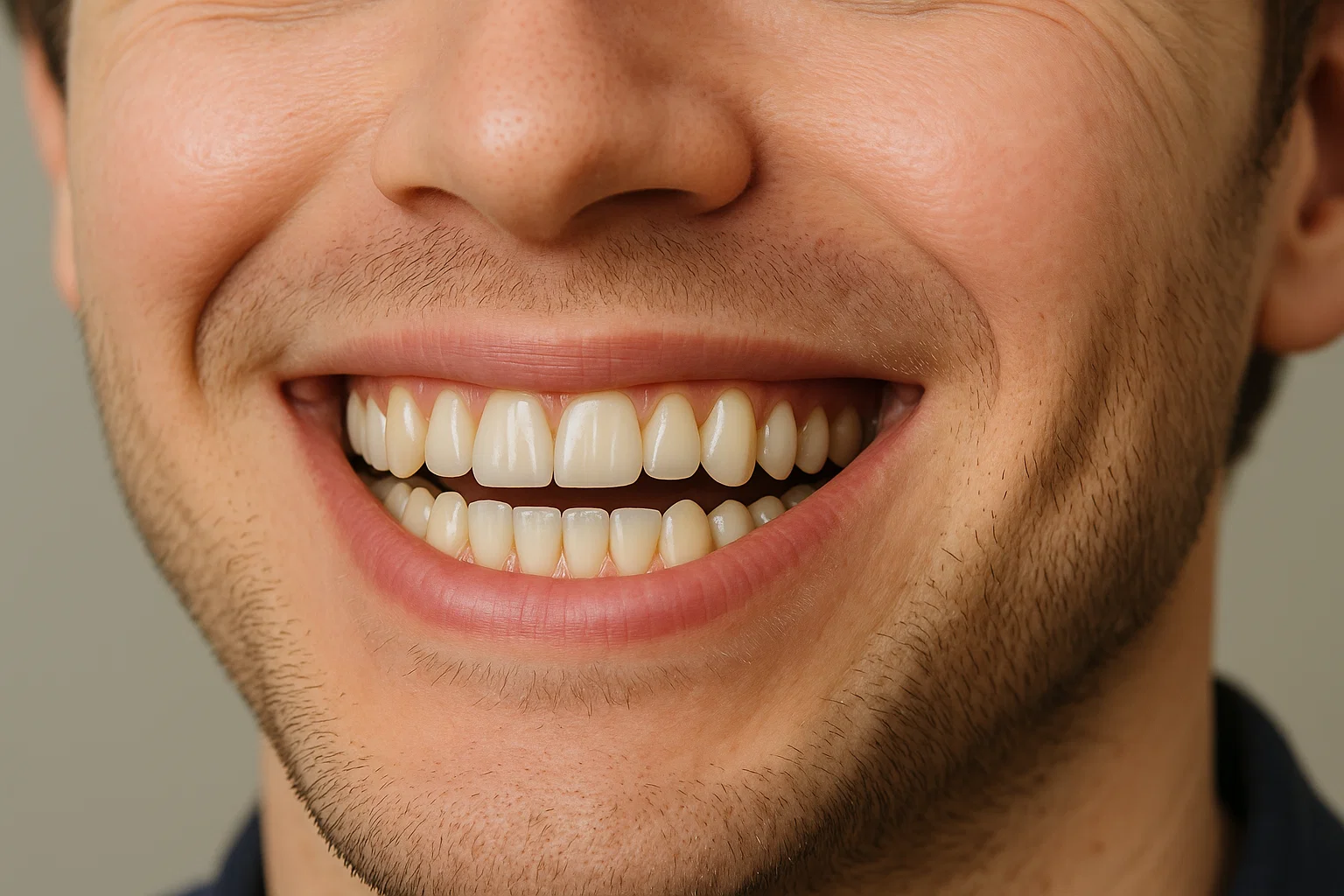Menu
Free Consultation

Ever wondered how many teeth humans have and why the number changes as we grow? Human dentition undergoes a remarkable transformation from infancy to adulthood. At birth, humans possess a set of 20 primary (baby) teeth, which gradually give way to 32 permanent (adult) teeth over the years. This transition is not just a simple replacement but a vital process that supports essential functions like chewing, speaking, and facial aesthetics. In this article, we will explore the number of teeth humans have at various life stages, delve into the anatomy and functions of these teeth, and provide essential care tips to maintain optimal oral health.
The first set of teeth, known as baby teeth or primary teeth, is vital for your child’s early development. While these teeth are temporary, they serve essential functions that help shape the foundation for a lifetime of healthy teeth. Baby teeth not only help with chewing and speaking, but they also create the necessary space for the adult teeth that will eventually replace them.
Humans typically have 20 primary (baby) teeth, which are essential for early oral development. These include:
These 20 teeth are distributed evenly across the upper and lower jaws, with 10 on top and 10 on the bottom. They play a vital role in speech development, chewing, and maintaining space for permanent teeth.
The eruption of baby teeth typically begins around 6 months of age and continues until approximately 3 years old. The process usually follows this general timeline:
After the eruption phase, these baby teeth begin to shed (exfoliate) to make room for permanent teeth. The shedding process typically starts around age 6 and continues until age 12 or 13. The order of shedding generally mirrors the eruption sequence, starting with the lower central incisors and progressing through the lateral incisors, first molars, canines, and second molars.
Despite being temporary, baby teeth are crucial for several reasons:
Maintaining the health of baby teeth is essential, as early loss due to decay or injury can lead to misalignment of permanent teeth. Regular dental check-ups and good oral hygiene practices should begin as soon as the first tooth appears. This includes brushing with a soft-bristle toothbrush and fluoride toothpaste, and flossing once two teeth touch.
As we grow, our dental needs evolve, and the transition from baby teeth to adult teeth is a significant milestone. Adult teeth, also known as permanent teeth, are designed to last a lifetime, provided they are properly cared for. These teeth are not just for biting and chewing; they also play a crucial role in speech, facial aesthetics, and overall health. Let’s explore how many adult teeth humans typically have, the role of wisdom teeth, and why taking care of your permanent set is essential for lifelong oral health.
Adults typically have 32 permanent teeth, which are essential for various functions such as chewing, speaking, and maintaining facial aesthetics. These include:
The full set of 32 adult teeth is typically achieved by the late teens. However, some individuals may have fewer teeth due to various reasons, such as tooth loss, extraction, or congenital conditions like hypodontia.
Wisdom teeth, also known as third molars, are the last set of adult teeth to emerge. They typically erupt between the ages of 17 and 25. However, some individuals may not develop them at all. In fact, about 25% of people worldwide never develop wisdom teeth.
Historically, wisdom teeth were useful for early humans who consumed a diet of raw plants and meat. As human diets and jaw sizes have evolved, the need for these extra molars has diminished. Consequently, many people today experience issues with their wisdom teeth, such as impaction, infection, or misalignment. In such cases, dental professionals often recommend removal.
Understanding the anatomy of a tooth is essential for appreciating its role in oral health. Each tooth is a complex structure composed of several layers, each serving specific functions vital for its overall performance.
A tooth is primarily divided into three regions: the crown, neck, and root. These regions are further composed of four main tissues: enamel, dentin, cementum, and pulp. Each tissue plays a unique role in maintaining the tooth's health and functionality.
Understanding the structure and function of each tooth layer highlights the complexity and importance of dental health. Maintaining enamel integrity, supporting dentin health, ensuring cementum stability, and preserving pulp vitality are all essential for overall oral well-being.
Maintaining healthy teeth is essential for overall well-being. Good oral hygiene practices not only prevent dental issues like cavities and gum disease but also contribute to better general health. In this section, we'll explore effective strategies to keep your teeth in optimal condition.
Brushing your teeth is the cornerstone of oral hygiene. Use a soft-bristle toothbrush and fluoride toothpaste to clean all surfaces of your teeth. Brush for at least two minutes, ensuring you reach the back molars and along the gumline. Brushing before bedtime is particularly important to remove the day's buildup of plaque and bacteria. If you prefer to brush after breakfast, wait at least 30 minutes to allow your enamel to remineralize, especially if you've consumed acidic foods or beverages.
Flossing removes food particles and plaque from between your teeth and under the gumline, areas your toothbrush can't reach. Daily flossing helps prevent cavities and gum disease. If traditional floss is challenging, consider using floss picks, interdental brushes, or a water flosser for easier access.
Mouthwash can help reduce oral bacteria, clean hard-to-brush areas, and freshen your breath. Choose an antimicrobial mouthwash to fight bacteria and a fluoride mouthwash to help prevent cavities. Avoid using mouthwash immediately after brushing, as it can wash away the concentrated fluoride left by toothpaste. Instead, use it at a different time during the day.
Your diet plays a significant role in oral health. Limit sugary snacks and drinks, as they can lead to tooth decay. Instead, opt for a balanced diet rich in fruits, vegetables, whole grains, and dairy products. These foods provide essential nutrients like calcium and vitamin C, which support strong teeth and gums. Be cautious with acidic foods and beverages, such as citrus fruits and sodas, as they can erode tooth enamel over time.
Smoking and using tobacco products can lead to gum disease, tooth loss, and oral cancer. They also stain your teeth and contribute to bad breath. Quitting tobacco use is one of the best things you can do for your oral and overall health.
Chewing ice may seem harmless, but it can cause serious damage to your teeth. The hard texture can crack or chip your enamel, leading to increased sensitivity or cavities. If you have a habit of chewing ice, consider substituting it with safer alternatives like sugar-free gum or crunchy fruits and vegetables.
Regular dental check-ups are crucial for maintaining oral health. Dentists can detect early signs of dental issues, provide professional cleanings, and offer personalized advice for your oral care routine. It's generally recommended to visit your dentist every six months, but your dentist may suggest more frequent visits based on your individual needs.
By incorporating these practices into your daily routine, you can maintain healthy teeth and gums, contributing to your overall health and well-being.
Maintaining healthy teeth is essential not only for a beautiful smile but also for overall health. By understanding the anatomy of your teeth and adopting a consistent oral care routine—brushing, flossing, using mouthwash, eating a balanced diet, and visiting your dentist regularly—you can keep your teeth in excellent condition for a lifetime.
Remember, your teeth are designed to last for many years, but they need proper care and attention. Small changes in your daily habits can lead to significant improvements in your oral health, preventing painful and costly dental issues in the future. So, take charge of your dental care today and enjoy the benefits of a healthy, confident smile for years to come!
